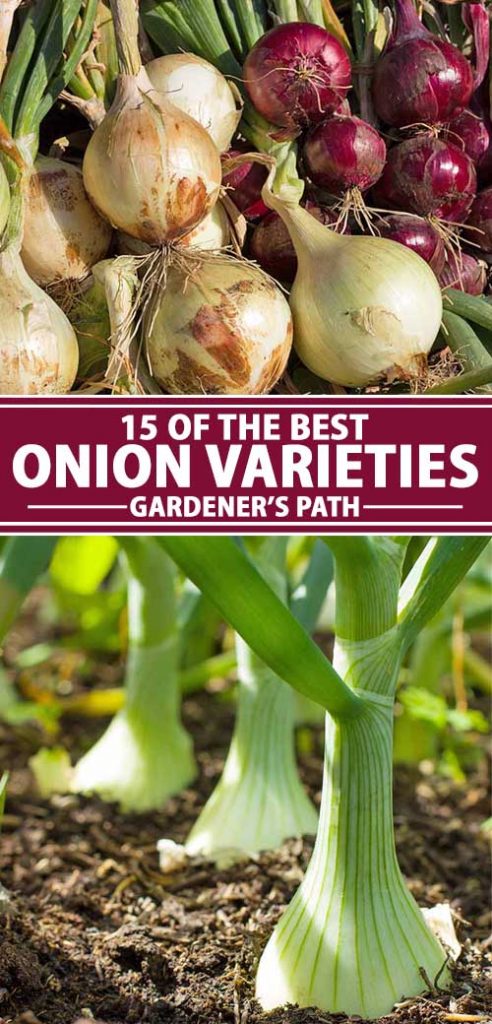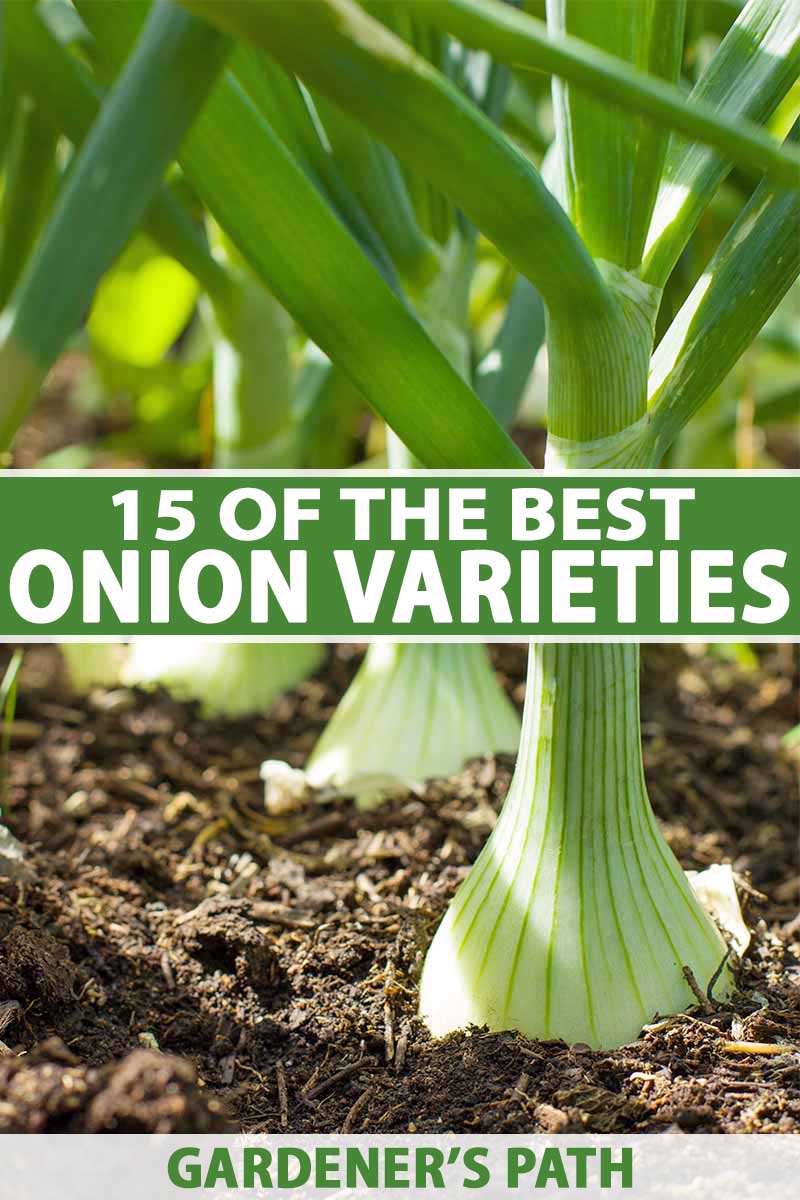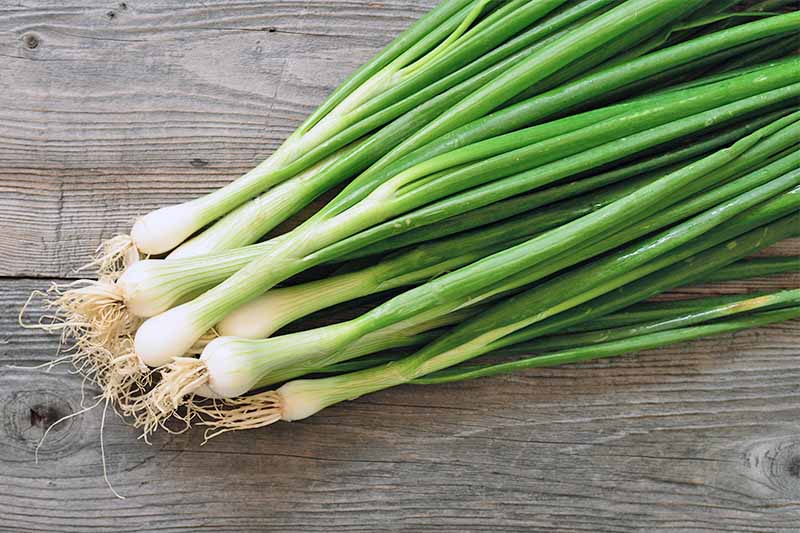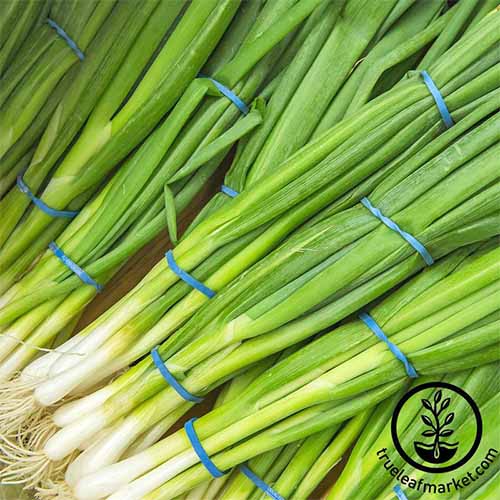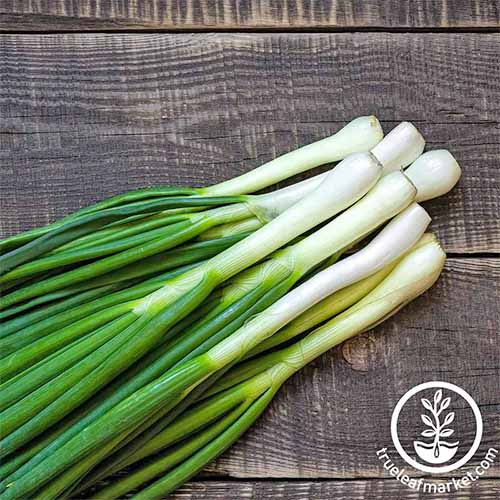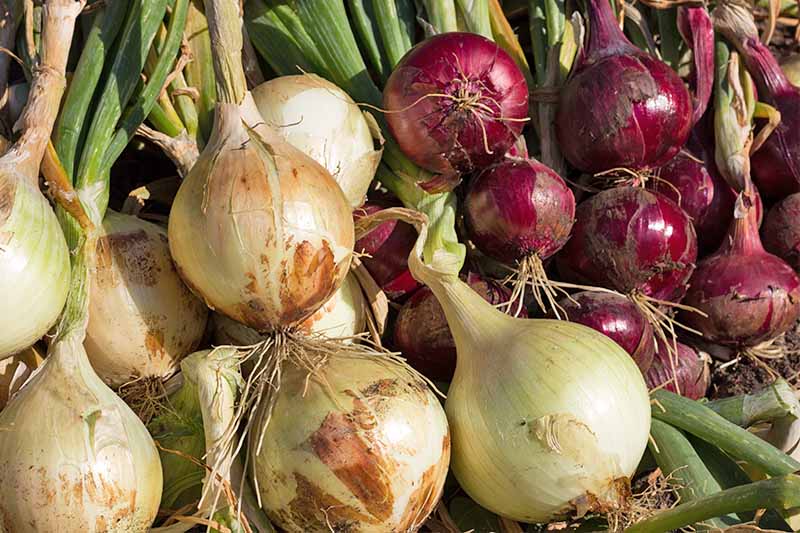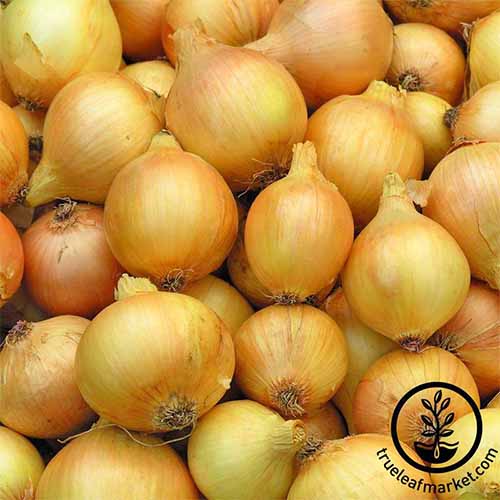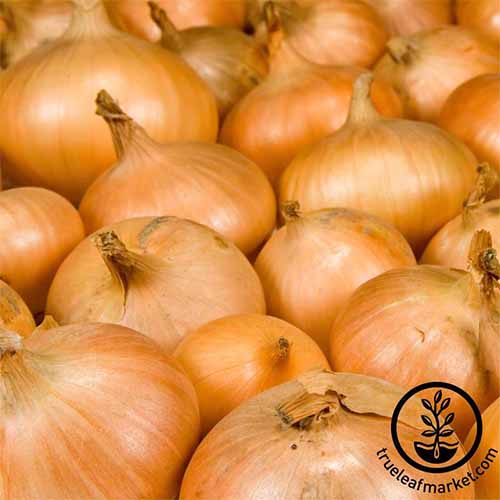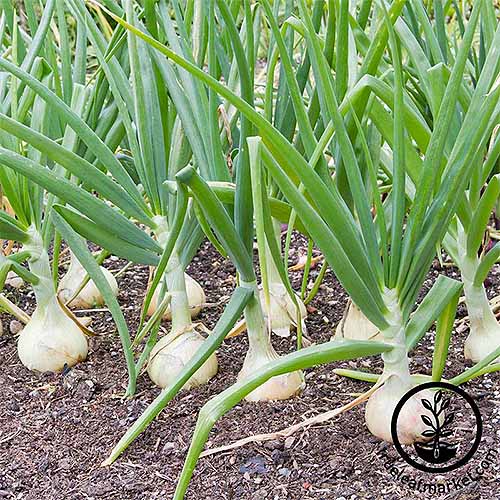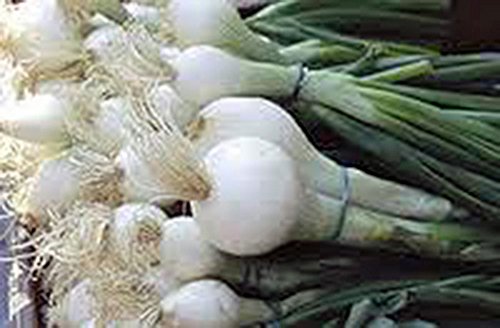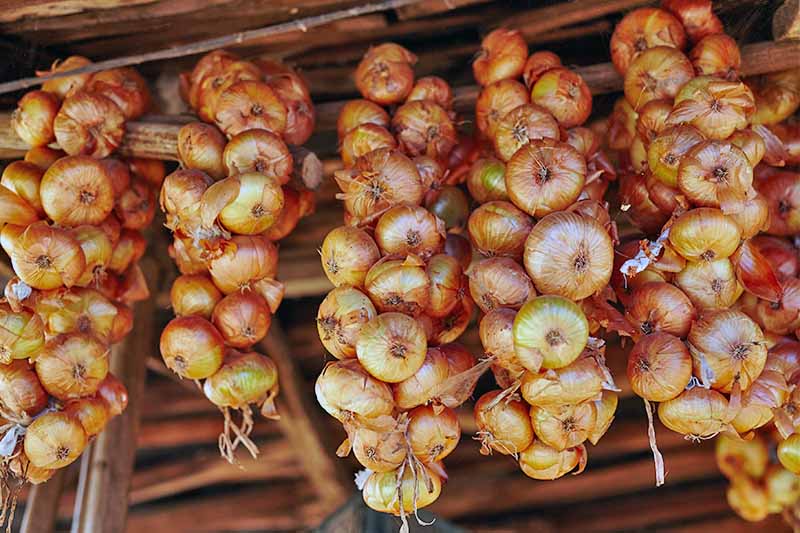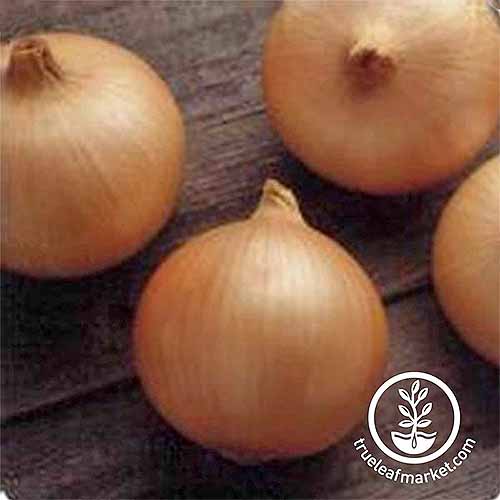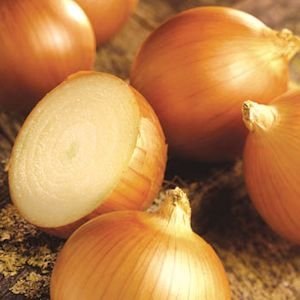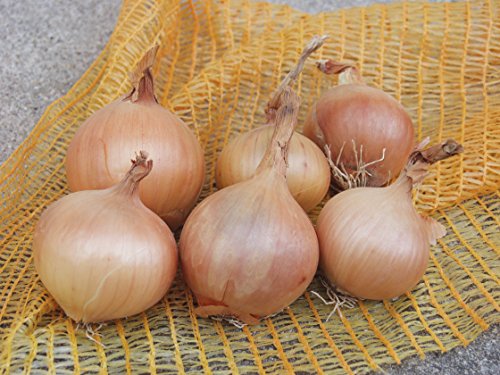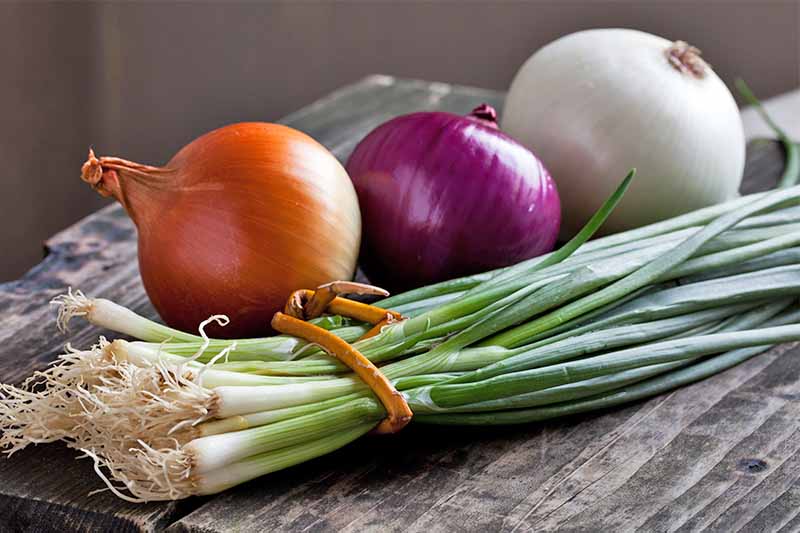We link to vendors to help you find relevant products. If you buy from one of our links, we may earn a commission.
The Final Word
Remember that in order to get a good long storage season, onions must be properly cured and left to adequately dry.
Super versatile, you can grow them in containers or plant them directly into the ground, which is wonderful for gardeners who might not have a large outdoor space. If you want more information, you can read our complete guide to growing these bunching types.
1. Crystal White Wax
‘Crystal White Wax’ The small, roundish bulbs of this variety are perfect for pickling, and they will reach maturity in about 95 days. With a mild, sweet flavor, you can expect these to produce larger bulbs in the south, or tiny pearls in the North. Want to take advantage of the tinier, pearl-sized variety in warmer climes? Just pick them earlier! Seeds are available from True Leaf Market.
2. Evergreen Long White
‘Evergreen’ Bunching These early beauties are certified organic and produce bunches of long, slim, tender stalks with green ends and small white bulbs at the root. They grow five to nine inches long and are ready to pull from the soil anytime after 65 days. These non-GMO seeds are robust producers and are well suited for spring or fall planting. Evergreen long white bunching seeds are available from True Leaf Market.
3. Tokyo Long White
‘Tokyo Long White’ Bunching Possibly the perfect green onion, ‘Tokyo Long White’ offers long white bulbs with sturdy blue-green tops. Though they’re not recommended for overwintering, they’re resistant to hot weather and reasonably cold tolerant as well, making them perfect for planting in a variety of climates. On top of that, they offer good resistance against pink root disease, smut, Botrytis leaf blight, and thrips. The Incredible Hulk of bunching onions! You’ll find they take 65-100 days to reach maturity, depending on where you’re located and when you plant. Get your seeds now, from True Leaf Market.
Fresh Onions
These will require a longer growing season to reach maturity. They have a sweet and less fiery flavor than storage cultivars, and are an extremely pleasant addition to any recipe.
If you’re growing a big crop, plan to share these with the neighbors (or revel in the joys of big batches of homemade soup)!
4. Ailsa Craig
200 Open-Pollinated ‘Ailsa Craig’ These large heirlooms are mild and sweet with beautiful gold-hued skins. Also known as ‘Kelsae Sweet Giant,’ they produce shorter stalks, which means they can be stored for a few weeks longer than other fresh types. With large white bulbs, ‘Ailsa Craig’ is a long-day variety that will be ready to harvest in about 100 days.
5. Italian Torpedo
300 Heirloom ‘Italian Torpedo’ This is a unique variety, with pinkish-red skins and an elongated shape. Often used in Italian cooking, this long-day cultivar has a sweet and mild flavor with tender flesh.
6. Red Burgundy
‘Red Burgundy’ This short-day globe type is best enjoyed fresh, producing large 3- to 4-inch bulbs that are white with red rings, and dark red skins. ‘Red Burgundy’ is an heirloom with a very mild and sweet flavor, and this type offers good resistance against pink root disease. Seeds are available from True Leaf Market.
7. Utah Yellow Sweet Spanish
‘Utah Yellow Sweet Spanish’ Another sweet variety, this long-day cultivar produces huge bulbs in about 115 days. An intermediate day type, they’re sweet and mild. If you’re located in the Western United States, this is the heirloom variety for you, since they’re well suited to local climatic conditions. They also do fairly well in storage. Seeds are available from True Leaf Market.
8. Walla Walla
‘Walla Walla’ Hailing from Washington State, this popular long-day variety is known to produce vegetables up to 2 pounds each! Extremely sweet and very mild, they have a higher water content than some varieties, so they may be cured but they don’t typically have a very extensive shelf life. After curing, your harvest may be stored in a cool, dark location like a pantry for about a month. Whether eating fresh or curing, bulb onions with a higher water content such as these will last longer if they are stored in the refrigerator. Chopped freezer storage is another excellent option for this variety, if you have a bumper crop. ‘Walla Walla’ can be grown in warmer or cooler climates, producing bulbs of various sizes, depending on when you choose to harvest. They will reach full maturity in about 90 days. Purchase organic ‘Walla Walla’ seeds from True Leaf Market.
9. White Grano
‘White Grano’ This short-day variety produces large, white, spherical bulbs in about 100 days. With soft, mild flesh that’s perfect chopped and sprinkled on a taco, these also lend themselves well to short term storage. Seeds treated for resistance to pink root disease are available from True Leaf Market.
10. White Sweet Spanish
100 Organic ‘Spanish White’ Seeds A compact white type, these are perfect for fresh summer salads, and lend a sweet and subtle flavor to any recipe. Also known as ‘Late White,” you can expect them to produce compact, white bulbs about three inches in diameter. This cultivar requires about 110 days to reach maturity, and is not meant for storage. As a long-day type, it is best suited to Northern gardens. But in the South, it can also be grown for harvest as a fresh green variety in the fall.
Storage Onions
These are the type that is known to stay fresh and usable long after they are pulled from the ground and cured. Storage cultivars tend to have smaller and more narrow necks that don’t hold as much moisture as fresh varieties. And less moisture means more crisp flesh that has a significantly more pungent flavor, and keeps months longer in storage.
11. Candy
‘Candy’ Hybrid This intermediate or day-neutral variety is a beautiful and reliable producer, with light yellow flesh and thin, paper-like skin. With a long and narrow stalk that doesn’t hold much moisture at all, the ‘Candy’ variety is known to keep very well in storage, if cured properly. These have a mild bite to them, but are pleasantly crisp and tangy. They will reach maturity after 200 days, and are delicious either fresh or from storage. 200 Hybrid ‘Candy’ Seeds This type is also available directly from True Leaf Market.
12. Patterson
200 ‘Patterson’ Seeds This long-day cultivar has a reputation amongst farmers for being one of the longest storing alliums on the market today. If you’re craving homegrown allium goodness year round, this is the type for you! ‘Patterson’ is easy to grow, and it’s a very hearty producer of 3- to 4-inch round bulbs that are firm, with a beautiful golden color. In terms of flavor, they have a bit of a bite to them, and are a mainstay in my daily cooking, from the early fall straight through the winter. They can be harvested any time after 105 days and, with proper curing, will remain fresh in cold storage for up to a year.
13. Redwing
1000 ‘Redwing’ Seeds These long-day alliums are famous for their deep red color and superior storage ability. They reliably produce large and round bulbs that are hard and crisp, with very thick skins. Ready for harvest in 115 days, when properly cured, this type will store for a year or more in a cool, dry place.
14. Southport Red Globe
Heirloom ‘Southport Red Globe’ This heirloom long-day variety produces large bulbs, with purple skins and pink flesh. Perfect for Northern gardens, you can expect high yields in about 100-120 days. Seeds are available from True Leaf Market.
15. Sturon
100 Burpee ‘Sturon’ Seeds This sweet variety produces high yields, and is ready for harvest in 80-100 days. A long-day type with medium-sized globes, brown skins, and yellow flesh, ‘Sturon’ is known for resisting bolting in hot weather. Onions are very adaptable, and extremely hardy. They prefer well-drained, somewhat acidic soil that has a pH level between 6.0 and 6.8. To learn more about testing your soil’s pH level, read our expert guide. Soil can be amended easily by adding lime, available in either powdered or pelleted form. Lime is a wonderful pH regulator, and is not harmful to plants or animals in any way. They will also need a certain minimum amount of sunlight in order to grow properly. Your garden’s location largely determines what types will work best for you. Let’s quickly cover the basics:
Short Day Varieties
Cultivars such as ‘Red Creole,’ ‘White Bermuda,’ or ‘Yellow Granex’ prefer about 10 hours of sunlight each day in order to form bulbs. This type grows well in more southern regions of the country, in USDA Hardiness Zones 7 and warmer.
Intermediate Day Varieties
Types such as ‘Candy’ or ‘Superstar’ require about 12-14 hours of sunlight per day before they will begin forming bulbs, but they are typically very adaptable. Most areas in the midsection of the US fall into this range, a large swathe of the country. Also referred to as “day neutral,” these varieties are best suited for growing zones 5 and 6, but will form bulbs in almost any zone. Unless you are in very northern or very southern regions, intermediate day varieties will grow quite well.
Long Day Varieties
Cultivars including ‘Walla Walla,’ ‘Copra,’ or ‘Yellow/White Spanish’ require 14-16 hours of sunlight in order to form bulbs. These varieties are usually grown in northern zone 6 and colder regions. Because of their amazing adaptability to fluctuations in temperature, they are known to be the best for storage. Your location should determine your selections in large part, so find out which growing zone you belong to, and plan accordingly. As a grower in Southern Vermont, I find that ‘Candy,’ ‘Ailsa Craig,’ ‘Patterson,’ and ‘Redwing’ are wonderful varieties for my growing zone. The bulbs produced are large and juicy, with a crispness that remains for the life of the vegetable.
This allows the moisture they contain to evaporate, leaving you with a firm, crisp, and dry vegetable that will store in a cool, dry place for many months to come. See our article on growing and harvesting onions for more information. With a little love and patience, and some proper fertilization and maintenance, you can have a beautiful, high-yielding crop that will be ready to eat fresh in the spring and summer, or stored and enjoyed throughout the fall and winter months.
After all, there is nothing better than eating food that you took the time to nurture, grow, and harvest. Now get out there! Happy planting. What are your favorite cultivars? Have any questions? Share with us in the comments below! And for more oniony goodness, check out some of our other guides:
How to Plant and Grow Egyptian Walking Onions
Product photos via True Leaf Market, Burpee, Hazzard’s Seeds, Jays Seeds, David’s Garden Seeds, and Country Creek Acres. Uncredited photos: Shutterstock. With additional writing and editing by Allison Sidhu.

